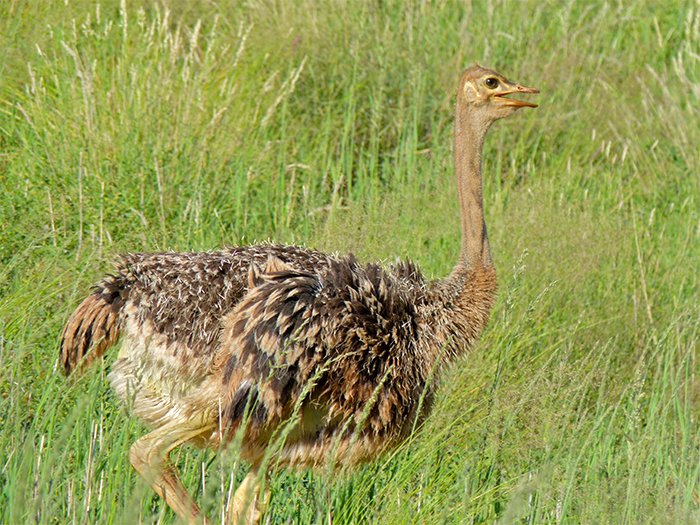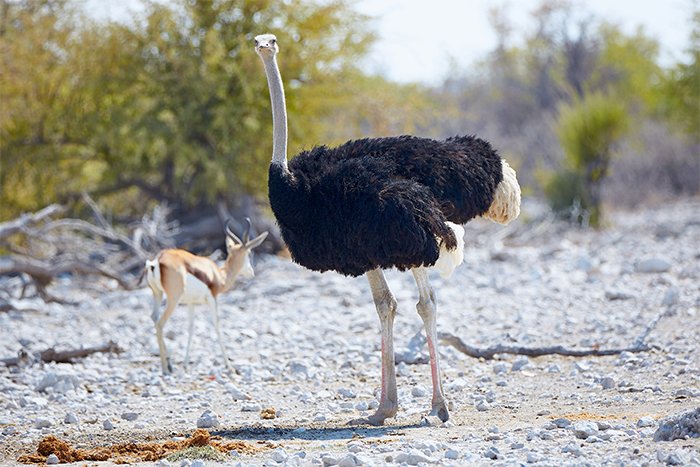Fastest Running Bird
(As an Adult)
Lip Kee Yap, CC BY-SA 2.0 https://creativecommons.org/licenses/by-sa/2.0, via Wikimedia Commons
Struthionidae
by Inspector Barry Mins on May 3, 2022Hey kids, welcome back to our series on the mysteries of created kinds!
This week we head to the African savannah looking for one of the most well-known birds in the world. They won’t be hard to find; they are also one of the largest birds in the world.

This bird is regularly featured on nature documentaries. It is the fastest living bird, able to run in bursts of over 40 miles an hour. It lives in groups of up to fifty birds. They live for a long time—over forty years under ideal conditions. One captive specimen lived to be over 62! They are found throughout Africa wherever there is open savannah and are among the more common animals in the region. They have large eyes, elevated atop their long necks, giving them excellent vision.
These birds often will travel with other popular denizens of the African savannah such as zebras, wildebeest, and gazelles as they share a similar diet. These birds prefer fresh grass, but will also eat other plant material when necessary.1 They will also sometimes eat small animals and insects but usually these are ingested as part of eating plants.2 These birds often get most of their water from the plants they eat. They also have a special means to raise their body temperature on a hot day to reduce water loss due to evaporation.3 Allowing the temperature to rise in this manner is most common in dehydrated birds and allows them to save almost twenty ounces of water!4
These birds breed communally, with three females usually laying their eggs in one nest and sometimes females laying eggs in multiple nests.5 The female typically incubates during the day and the male at night, which might be a way to help camouflage the nest as the males’ darker plumage is harder to detect at night.6 The chicks hatch after just over a month. Very few will survive to adulthood, but the ones that do are likely to live a long time. Due to their high speed and ability to kill a predator with their kick, these birds are not preferred prey for most predators.
Has anyone figured it out yet? This week is easy. This week’s kind is the Struthionidae, the ostriches. There are one to two species of ostrich (depending on who you ask) and they are both common and well-known throughout the world due to their appearance on nature documentaries.
Try out this fun word search!
Clue
Your clue for the next week is:
This kind has a special gland that allows it to send chemical signals to communicate with other members of its kind.
Ask a Question
Have you ever had a question about created kinds but didn’t know who to ask? Have you ever wanted to learn more about your favorite kind? Well, now you can! You can ask me, Inspector Barry Mins, a question! Have your parents help you fill out this form, and you might get your question answered in my column! If you have any questions about created kinds, feel free to send them my way!
Footnotes
- Suzanne J. Milton, W. Richard J. Dean, and W. Roy Siegfried, “Food Selection by Ostrich in Southern Africa,” The Journal of Wildlife Management 58, no. 2 (1994), 234–248.
- R.G. Cooper, “Structure and Function of the Ostrich (Struthio Camelus var Domesticus) Gut: Nutritional Impact,” in Avian Gut Function in Health and Disease Poultry Science Symposium Series, 28, ed. G.C. Perry (Oxon: CABI, 2005), 361.
- M.A. Paleari, P. Corsico, and G. Beretta, “The Ostrich: Breeding, Reproduction, Slaughtering, and Nutritional Value of the Meat,” Fleischwirtschaft, 75 (1995), 1120–1123.
- Kurt Schmidt-Nielsen, John Kanwisher, Robert C. Lasiewski, Jerome E. Cohn, and William L. Bretz, “Temperature regulation and respiration in the ostrich,” The Condor, 71 (1969), 341–352.
- M.J.F. Jarvis, C. Jarvis, and R.H. Keffen, “Breeding Seasons and Laying Patterns of the Southern African Ostrich Struthio Camelus,” IBIS, 127, no. 4 (1985), 442–449.
- Ross G. Cooper, Jaroslaw O. Horbanczuk, Raul Villegas-Vizcaino, Salwa Kennou Sebei, Aisha E. Faki Mohammed, and Khalid M.A. Mahrose, “Wild Ostrich (Struthio Camelus) Ecology and Physiology,” Tropical Animal Health Products, 42, (2010), 363–373.
- © 2025 Answers in Genesis
- Privacy Policy
- Contact
- About


